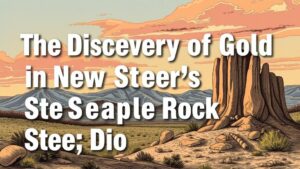The History of the Apache No. 2 Gold Mine in the Black Range
The History of the Apache No. 2 Gold Mine in the Black Range
The Apache No. 2 Gold Mine, located in the Black Range of New Mexico, represents a significant chapter in the mining history of the American West. This mine is noteworthy not only for its production of gold but also for the impact it had on local communities and the evolution of mining techniques during the late 19th and early 20th centuries.
Geological Context and Discovery
The Black Range, a mountainous region in southern New Mexico, is rich in mineral resources, primarily due to its complex geological formation. The area is characterized by volcanic intrusions and sedimentary rock layers, which created ideal conditions for gold deposits. The discovery of gold in this region can be traced back to the mid-1800s, although serious exploration did not begin until the 1880s.
- The precise discovery of gold in the Apache No. 2 occurred in 1893.
- Miners utilized a technique known as placer mining, which involves extracting gold from river sediments.
This historical context highlights how geological phenomena can influence economic developments in specific regions.
The Rise of the Apache No. 2 Mine
By the late 1890s, the Apache No. 2 Gold Mine had established itself as a key player in New Mexico’s mining industry. mines infrastructure included shafts, tunnels, and processing facilities, demonstrating the shift from rudimentary mining practices to more sophisticated operations.
- The mines production peaked in the early 1900s, yielding substantial quantities of gold.
- Records indicate that the mine produced nearly $1 million worth of gold between 1893 and 1910.
This success attracted thousands of prospectors and laborers to the region, which in turn spurred the growth of towns nearby, such as Chloride and Kingston. The social implications of mining booms often include both economic vitality and the challenge of managing a transient workforce.
Technological Innovations
The operation of the Apache No. 2 Gold Mine also coincided with major technological advancements in mining. This included the adoption of more effective extraction techniques such as cyanidation, a process that involves the use of cyanide to extract gold from ore.
- The introduction of steam-powered machinery in the 1890s allowed for deeper mining, significantly increasing gold yields.
- Electricity, introduced shortly thereafter, facilitated night-time operations and enhanced safety for miners.
Such innovations not only transformed the mining landscape but also improved safety standards, which were paramount given the dangerous nature of the work.
Challenges and Decline
- By the 1930s, many smaller mines, including Apache No. 2, had shut down due to unprofitability.
- Labor disputes also arose as workers sought better wages and working conditions, reflective of broader labor movements across the country.
Legacy and Modern Context
Today, the Apache No. 2 Gold Mine stands as a historical landmark that reflects the tumultuous and dynamic narrative of mining in the American Southwest. While the mine ceased operations, the legacy of these mining operations has continued to influence local economies and culture.
- The remnants of the mine can still be explored, serving as a tangible link to the past for historians and tourists alike.
- Current discussions around mining often revisit the balance of resource extraction and environmental stewardship, prompted by lessons learned from past practices.
Conclusion
In summary, the Apache No. 2 Gold Mine in the Black Range is more than just a relic of mining history; it encapsulates economic growth, technological progress, and the complexities of labor relations. Understanding this history equips us to better appreciate the nuanced challenges and advancements in modern mining practices.
As we reflect on the Apache No. 2 Gold Mine, it underscores the importance of responsible mining and the ongoing dialogue concerning environmental impacts and sustainable resource management. It serves as a reminder that mining has shaped not only the geography of regions like the Black Range but also the lives and communities of those who inhabited them.

